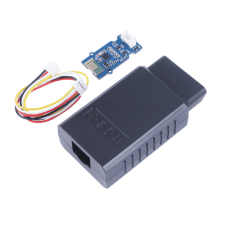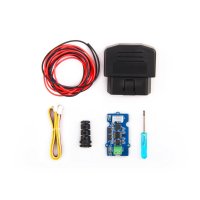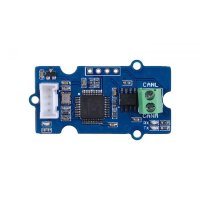OBD-II RF Dev Kit helps you communicate wirelessly with your vehicle's OBD-II interface using RF (Radio Frequency) through hundreds of meters, which means you can remotely process your vehicle property value data. We also provide tutorials based on Arduino about how you start with it and get data from vehicles.
Are you still looking for can-bus products for use? Check out our car hacking tools here and choose the best product for you.
What is OBD-II?
OBD-II (short terms for On-Board Diagnostics, Second Generation) is a set of standards for implementing a computer-based system to control emissions from vehicles. Also, it can be explained as a vehicle's built-in self-diagnostic system. When your vehicle has an internal issue, normally it would pop up a malfunction indicator light on your dashboard, telling you to visit the broken mechanic and get the problem fixed. In the past, this light would just light up to indicate the vehicle is broken, but it was not possible to identify where the issue was. Nowadays, the OBD-II built inside vehicles, allows you to identify the exact problem of the vehicle by connecting an OBD-II reader to the OBD-II 16-pin connector built inside the vehicle. Through this, it has been possible to read OBD-II codes, also known as Diagnostic Trouble Codes (DTCs) which help understand the issues, and there is no need to completely disassemble the vehicle.
What is OBD-II RF Dev Kit and how does it work?
Usually, there is an OBD-II interface on the vehicle for the user to read some data through the CAN-Bus interface, such as vehicle speed, engine speed, and oil temperature, etc. And 'RF' stands for 'Radio Frequency', it can help to transmit data through hundreds of meters without CAN-Bus or any cable. With the RF device kit, the data about vehicles can be transmitted wireless to other devices like microcontrollers.
- OBD-II RF Dev Kit includes two parts: the transmitter and the receiver. The transmitter is inserted into the OBD-II interface of the vehicle, integrating with the CAN-Bus interface and RF communication. That means it can transmit the data read by CAN-Bus to the remote end through radiofrequency. The receiver is a Serial RF Module, which can send the data from the receiving end to the microcontroller through the serial port.
- Additionally, if you want to build some interesting projects about using vehicle data and remotely processing with it, we highly recommend you use this OBD-II RF Dev Kit for your projects. Also, we have OBD-II CAN-BUS Development Kit for fast and stable data transmission and an interesting project about car "hacking" using CAN bus via Wio Terminal, which is really fun.
What is CAN-BUS?
CAN stands for Controller Area Network, it is used to allow microcontrollers and devices to communicate with each other within a vehicle without a host computer which allows for control and data acquisition. These devices are also called Electronic Control Units (ECU) and they enable communication between all parts of a vehicle.
Today, you can find up to 70 ECUs in a modern car. CAN is a serial communication bus designed for industrial and automotive applications. For example, they are found in vehicles, farming equipment, industrial environments, etc.
How does CAN-BUS work?
The fuel level, door sensors, odometer, and many more parts of a car have to communicate with each other somehow, and CAN BUS is what they used to do. These CAN-compatible components, which are called “nodes” are connected with a 3-string copper wire, with no central router to govern the flow of data. Every node can hear the messages of every other node.
- Every node has an ID, where the ones with the higher priority ID can have the priority to “talk” first while the others “listen”. This is to ensure that there are never two nodes talking at the same time. The biggest benefit of CAN-BUS is to be able to just connect components without having to worry about signal routing.
Learn more about CAN-BUS here.

Features:
- High-performance communication: supports CAN 2.0 which features a 120m communication distance in the wild
- Supports Radio Frequency(RF) communication: transmitting data wirelessly through 2.4 GHz radiofrequency
- Simple development: Arduino library provided
- Easy to diagnose a vehicle: identify the problem without disassembling the vehicle
- Supports remote diagnosis: RF transmits data through hundreds of meters without CAN-Bus or any cable
Specification
- Parameter: Value
- MCU: Atmega 168PA
- Barurate: 9600
- Communication distance: 120m
- Power input of the transmitter: 12V
- Power input of the receiver: 3.6V
Technical Details
- Dimensions: 180mm x 110mm x 20mm
- Weight: G.W. 53g
- Battery :Exclude
- ECCN/HTS
- HSCODE 8517180050
- USHSCODE: 8517180050
- UPC
- EUHSCODE: 8517180000
- COO: CHINA
- EU DoC: 1
- RoHS: 1
- UK DoC: 1
Application:
- Car Hacking: read data such as vehicle speed, engine speed and oil temperature through the CAN-BUS interface, and send data through RF to you for further diagnosis. Using a Wio Terminal as HMI to interact with the device.
- Remotely diagnose the vehicles: No need wiring, the RF will transmit data through hundreds of meters.
Package Includes:
- 1 x The transmitter with a case
- 1 x The receiver module
- 1 x Grove Cable
CAN BUS OBD-II RF Dev Kit - 2.4Ghz wireless - Arduino Support
- Brand: Seeed Studio
- Product Code: Seeed-CAN-BUS-OBD-II-RF-Dev-Kit
- Reward Points: 25
- Availability: In Stock
-
रo 2,462.00
- Price in reward points: 2462
-
- 80 or more रo 2,276.00
Related Products
OBD-II CAN-BUS Development Kit
OBD-II (short for On-Board Diagnostics, Second Generation) is a set of standards for implementing a ..
रo 2,350.00
Grove - CAN BUS Module based on GD32E103, CAN FD supported
This Grove - CAN BUS Module based on GD32E103 adopts a brand-new design, uses the cost-effective and..
रo 689.00






